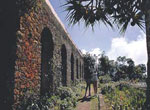“THE BIG ROCK” IN SANTIAGO DE CUBA: EASTERN CUBA TREASURE.
The Big Rock, treasure of Eastern Cuba. Gigantic mass of stone, witness of the volcanism of the Paleogene, like all the geology of the Sierra Maestra, where are these strata of this type of rocks, composed of tuffs, ash and other fragments of rocks and liquids, like beds of volcanic lava.
Located on the Carretera de Siboney and road the great stone km 14, Santiago de Cuba.
The enormous rock of volcanic gap, 51 meters long and 25 to 30 meters wide, with an estimated weight of 63 000 tons is on top of a mountain 1 225 meters above the sea level. Natural viewpoint from where you can see the Sierra Maestra.
Area of settlement of French colonists in the 18th and 19th centuries who made constructions that are outstanding examples of vernacular and industrial architecture. The ruins of dozens of these settlers coffee plantations are also preserved from that time. This is precisely, the high point of the mountain system, with a height of thousand 225 meters above sea level built into the attractions that make up the Gran Parque Nacional Sierra Maestra.
The mole is famous not only among the borders of the island, but also in the region of the Caribbean island, as it is precisely that of larger size in that area.
The legends of its origin range to versions attributed his training due to the impact of a meteorite that fell to makes millions of years into that Eastern territory, although the most true is that which considers its birth due to the explosion of a submarine volcano. It is currently considered a national monument.
The flora is unique, composed 222 varieties of ferns, and 352 of orchids, eucalyptus, maestrenses, cubenses, Cypress pine, and a variety of fruit trees including by unusual as it seems, legitimate apples and peaches.
The fauna of the great stone is one of the strongest attractions. Around the mole, thrown by the volcano, woodpeckers, thrushes real, Charter flying birds cubas, hawks, pigeons, mayito, led by our national bird, the tocororo. Just a kilometre is the Botanical Garden, where they grow exceptionally, species like the bird of paradise, dahlias, magnolias and other cold weather, taking advantage of the micro-climate that prevails in the area. The curtain of clouds down touching the upholstered floor always wet moss, usually impregnate the gathering of men with the mass of stone, which only the huge force generated in the bowels of a volcano, could have thrown up that mountain of mystery and enigma.
Agencies/Wiki/Internet Photos/EcuRed/YouTube/TheCubanhistory.com
The Cuban History, Hollywood.
Arnold Varona, Editor.
CUBA PHOTOS.
Veneración de la Virgen de Regla, Cuba.

“LA GRAN PIEDRA”, SANTIAGO DE CUBA.UN TESORO DEL ORIENTE CUBANO.
La Gran Piedra, tesoro del oriente cubano. Gigantesca mole de piedra, testigo del vulcanismo del Paleógeno, al igual que toda la geología de la Sierra Maestra donde están presentes estratos de este tipo de rocas, compuestas de tobas, ceniza y demás fragmentos de rocas y productos líquidos, como mantos de lava volcánica.
Ubicada en la Carretera de Siboney y Carretera la Gran Piedra km. 14, Santiago de Cuba.
La Enorme roca de brecha volcánica, de 51 metros de largo y de 25 a 30 metros de ancho, con un peso calculado de 63 000 toneladas se encuentra en la cima de una montaña a 1 225 metros de altura sobre el nivel del mar. Mirador natural desde donde se observa la Sierra Maestra.
Zona de asentamiento de colonos franceses en los siglos XVIII y XIX, que realizaron construcciones que son ejemplos excepcionales de arquitectura vernácula e industrial. También se conservan de esa época las ruinas de decenas de plantaciones de café de estos colonos. Precisamente, ese es el punto culminante del sistema montañoso, con una altura de mil 225 metros sobre el nivel del mar e integrado en los atractivos que conforman el Gran Parque Nacional Sierra Maestra.
La mole es famosa no solo entre las fronteras de la isla, sino también en la región del Caribe insular, pues es precisamente la de mayor tamaño en esa zona.
Las leyendas de su origen abarcan hasta las versiones que le atribuyen su formación debido al impacto de un meteorito que cayó hace millones de años en el mencionado territorio oriental, aunque la más verídica es aquella que considera su nacimiento debido a la explosión de un volcán submarino. Actualmente es considerado Monumento Nacional.
La flora es exclusiva, pues la componen 222 variedades de helechos, y 352 de orquídeas, eucaliptos, pinos maestrenses, cubenses, cipreses, y una variedad de frutales entre ellos, por insólito que parezca, manzanas legítimas y melocotones.
La fauna de la Gran Piedra es, uno de los atractivos más fuertes. En torno a la mole arrojada por el volcán, vuelan pájaros carpinteros, zorzales reales, carta cubas, gavilanes, torcazas, mayitos, capitaneados por nuestra ave nacional, el tocororo. A sólo un kilómetro se encuentra el Jardín Botánico, donde se cultivan de forma excepcional, especies como el ave del paraíso, las dalias, magnolias y otras de climas fríos, aprovechando el microclima que reina en la zona. La cortina de nubes que baja hasta tocar el suelo tapizado de musgos siempre húmedos, suele impregnar de misterio y enigma el encuentro de los hombres con la mole de piedra, que sólo la fuerza descomunal generada en las entrañas de un volcán, pudo haber lanzado hasta aquella montaña.
Agencies/Wiki/InternetPhotos/EcuRed/YouTube/TheCubanhistory.com
The Cuban History, Hollywood.
Arnoldo Varona, Editor.





